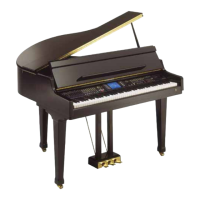○○○○○○○○○○○○○○○○○○○○○○
4•2 Reference Guide
○○○○○○○○○○○○○○○○○○○○○○
4•2 Reference Guide
The table below shows the valid commands for
each file type:
File Type Command
Block Single
Setup Single
Sound Single, Group, All
Global Preset Single, Group, All
Style Preset Single, Group, All
User Styles Single, Group, All
Song Single, Group, All
MIDIFile Single
THE FILE SELECTOR
Once specified, press ENTER to confirm your
selection in the main DISK page and enter the
file Selector. The File selector is where you can
select the source files and respective destina-
tions.
Again, the display divides into two parts. On the
left is the directory of the file origin (floppy, hard
disk, etc.) and on the right side is the main direc-
tory of something called RAMFILE (Random Ac-
cess Memory). This is the name given to the PS/
GPS’s internal memory. Everything currently
stored in memory, Sounds, Presets, Styles,
Songs, etc., are contained in the RAMFILE. De-
pending on the type of file selected in the main
page, the RAM directory lists the files currently
residing in the instrument’s memory.
For example, if you selected Save Single Song
in the main page, entering the File Selector will
show the RAM directory listing all the Songs
present in the PS/GPS RAM memory.
Empty locations are represented by a broken line.
If you select a destination already occupied by a
file, the existing file is replaced by the incoming
one.
The table below shows the valid commands for
each file type:
File Type Command
Block Single
Setup Single
Sound Single, Group, All
Global Preset Single, Group, All
Style Preset Single, Group, All
User Styles Single, Group, All
Song Single, Group, All
MIDIFile Single
THE FILE SELECTOR
Once specified, press ENTER to confirm your
selection in the main DISK page and enter the
file Selector. The File selector is where you can
select the source files and respective destina-
tions.
Again, the display divides into two parts. On the
left is the directory of the file origin (floppy, hard
disk, etc.) and on the right side is the main direc-
tory of something called RAMFILE (Random Ac-
cess Memory). This is the name given to the PS/
GPS’s internal memory. Everything currently
stored in memory, Sounds, Presets, Styles,
Songs, etc., are contained in the RAMFILE. De-
pending on the type of file selected in the main
page, the RAM directory lists the files currently
residing in the instrument’s memory.
For example, if you selected Save Single Song
in the main page, entering the File Selector will
show the RAM directory listing all the Songs
present in the PS/GPS RAM memory.
Empty locations are represented by a broken line.
If you select a destination already occupied by a
file, the existing file is replaced by the incoming
one.
○○○○○○○○○○○○○○○○○○○○○○
4•2 Reference Guide
○○○○○○○○○○○○○○○○○○○○○○
4•2 Reference Guide
The table below shows the valid commands for
each file type:
File Type Command
Block Single
Setup Single
Sound Single, Group, All
Global Preset Single, Group, All
Style Preset Single, Group, All
User Styles Single, Group, All
Song Single, Group, All
MIDIFile Single
THE FILE SELECTOR
Once specified, press ENTER to confirm your
selection in the main DISK page and enter the
file Selector. The File selector is where you can
select the source files and respective destina-
tions.
Again, the display divides into two parts. On the
left is the directory of the file origin (floppy, hard
disk, etc.) and on the right side is the main direc-
tory of something called RAMFILE (Random Ac-
cess Memory). This is the name given to the PS/
GPS’s internal memory. Everything currently
stored in memory, Sounds, Presets, Styles,
Songs, etc., are contained in the RAMFILE. De-
pending on the type of file selected in the main
page, the RAM directory lists the files currently
residing in the instrument’s memory.
For example, if you selected Save Single Song
in the main page, entering the File Selector will
show the RAM directory listing all the Songs
present in the PS/GPS RAM memory.
Empty locations are represented by a broken line.
If you select a destination already occupied by a
file, the existing file is replaced by the incoming
one.
The table below shows the valid commands for
each file type:
File Type Command
Block Single
Setup Single
Sound Single, Group, All
Global Preset Single, Group, All
Style Preset Single, Group, All
User Styles Single, Group, All
Song Single, Group, All
MIDIFile Single
THE FILE SELECTOR
Once specified, press ENTER to confirm your
selection in the main DISK page and enter the
file Selector. The File selector is where you can
select the source files and respective destina-
tions.
Again, the display divides into two parts. On the
left is the directory of the file origin (floppy, hard
disk, etc.) and on the right side is the main direc-
tory of something called RAMFILE (Random Ac-
cess Memory). This is the name given to the PS/
GPS’s internal memory. Everything currently
stored in memory, Sounds, Presets, Styles,
Songs, etc., are contained in the RAMFILE. De-
pending on the type of file selected in the main
page, the RAM directory lists the files currently
residing in the instrument’s memory.
For example, if you selected Save Single Song
in the main page, entering the File Selector will
show the RAM directory listing all the Songs
present in the PS/GPS RAM memory.
Empty locations are represented by a broken line.
If you select a destination already occupied by a
file, the existing file is replaced by the incoming
one.

